Generating effective leads is no walk in the park. Visitors, such as investors and managers to your website might not even notice your product or service, or they may show some interest but then leave for something they find more suitable.
Some might disappear completely, leaving you unsure if they ever planned to engage. The worst is when the consumers do not reply for weeks after the signup process. Turning a stranger into a customer is often challenging.
Overcoming such challenges is important for business growth, and thus, this lead generation guide provides valuable insights into attracting attention, nurturing leads, and turning potential prospects into lasting clients.
What is a Lead, and What are the Types of Lead?
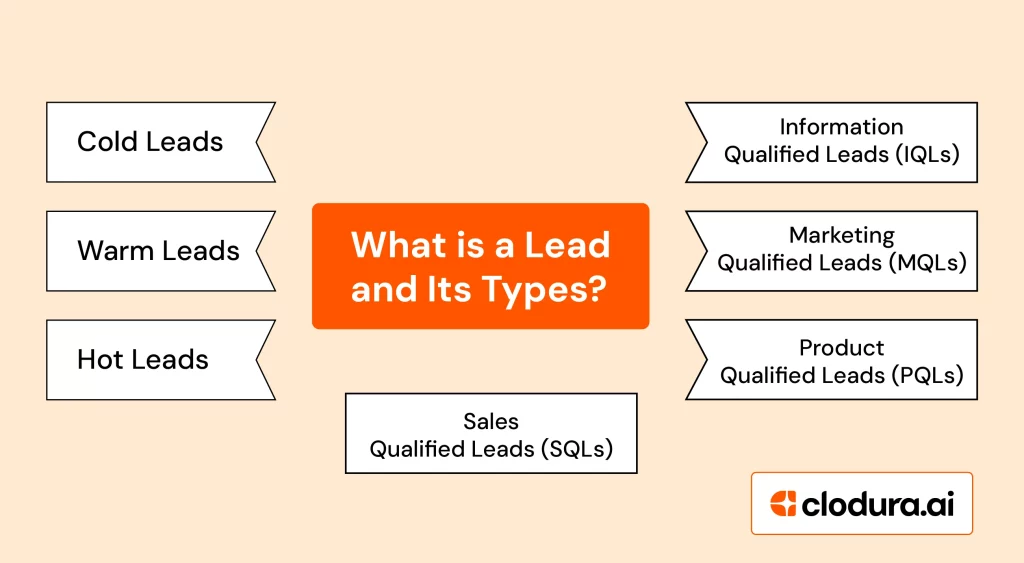
A lead is a person or prospect showing active interest in a service/product. Leads tend to provide personal information about themselves, which the company later responds to. This information is offered to the organization as a free trial or subscription.
Leads are transient prospects between visitors and customers and constitute seven important kinds. Let us take a look at the table given below:
| Types of Lead | Definition | Examples |
|---|---|---|
| Cold Leads | Leads that qualify for your ICP but haven’t interacted with your company |
|
| Warm Leads | Leads that are aware of your product but haven’t shown any interest in it |
|
| Hot Leads | Leads showing additional interest in your product |
|
| Information Qualified Leads (IQLs) | Leads searching for a solution to their problem can be targeted with information content |
|
| Marketing Qualified Leads (MQLs) | Leads that are aware of your brand and engage with its content |
|
| Product Qualified Leads (PQLs) | Leads that already received some ROI from the product |
|
| Sales Qualified Leads (SQLs) | Leads showing active interest in your product/service |
|
Want To Elevate Sales With Seamless Lead Generation?
Clodura.AI helps users develop an efficient marketing funnel that boosts their sales through high-quality lead generation, which increases their sales pipeline.
Book a DemoWhat is Lead Generation?
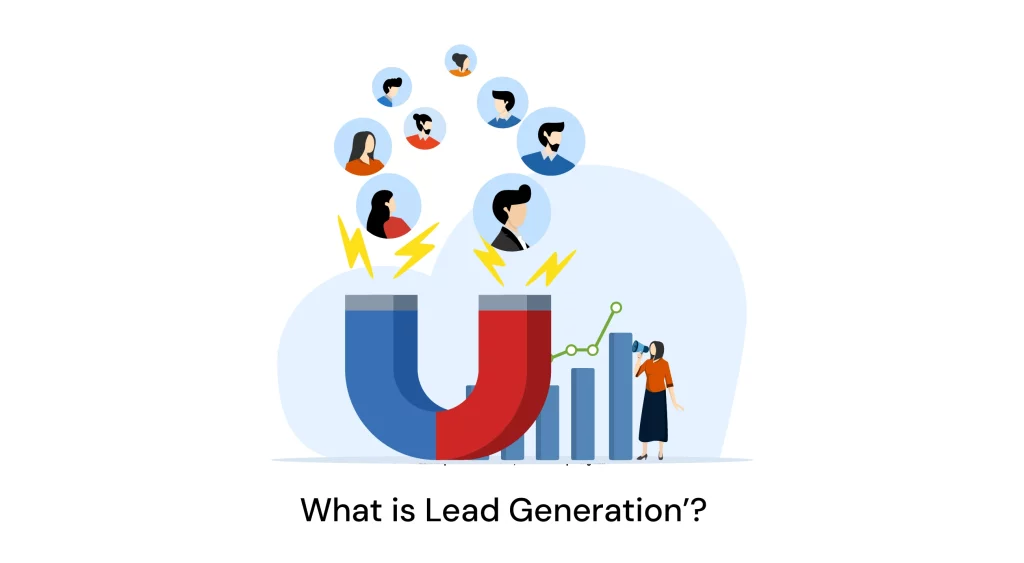
Lead generation is the process of developing interest in a product or service among potential leads and turning that interest into a sale. The lead is generated by acquiring the visitor’s contact details through different channels, such as web forms on landing pages. Lead generation is largely considered the initial stage of a B2B marketing funnel.
Lead generation facilitates the sales cycle by making it more efficient. By targeting only the strongest and most valuable prospects, we can better convert and generate the right leads. The success rate is also measured through KPIs like conversion rates, cost per lead, and lead quality.
Lead generation typically involves:
- Attracting potential leads through marketing efforts, such as content marketing, advertising, or social media.
- Engaging with leads through landing pages, web forms, or other conversion points.
- Capturing lead information, such as names, email addresses, or phone numbers.
- Nurturing leads through targeted communication, such as email marketing or sales outreach.
Lead generation aims to create a steady flow of marketing-qualified leads that can be converted into customers, driving business growth and revenue.
Why is Lead Generation Important for Businesses?

Lead generation is vital for businesses worldwide because it enables them to influence potential customers at the beginning of the sales cycle. Since buyers, in general, are more distracted than ever in their buying process, this tactic helps them sell their business product quickly.
Here are the key benefits of lead generation with varied business sectors examples:
- Increased Conversions: Lead generation helps businesses convert potential customers into paying clients through sales intelligence and engagement software.
Example: An e-commerce business uses lead generation to convert more website visitors into customers, significantly increasing monthly sales.
- Revenue Amplification: Effective lead generation strategies drive revenue growth and expansion.
Example: A software company specializing in project management tools implements a lead generation strategy targeting large enterprises.
- Competitive Advantage: Consistently generating high-quality leads sets businesses apart from their competitors.
Example: A specialized orthopedic clinic implements a lead capture strategy to differentiate it from general healthcare and clinics in the area.
- Improved Sales Efficiency: Qualifying leads ensures sales teams focus on promising opportunities, saving time and resources.
Example: A financial services company uses lead qualification to reduce its sales team’s workload, allowing it to focus on high-value clients and increase sales.
- Enhanced Customer Insights: Lead generation provides valuable customer behavior and preferences data, informing marketing strategies. Clodura’s advanced analytics and AI-driven insights enable businesses to understand their customers better, creating personalized experiences that drive engagement and conversion.
Example: Fast-Moving Consumer Goods (FMCG) company uses lead generation data to identify a new product opportunity in the growing market of eco-friendly cleaning products.
- Scalability: A robust lead capture process enables businesses to scale quickly and efficiently.
Example: A fintech startup offering a digital payment solution uses lead generation to rapidly expand its customer base from 1,000 to 10,000 businesses within 6 months.
By automating lead capture, they can handle the increased volume of leads without proportion.
Lead generation helps businesses increase conversions, amplify revenue, and gain a competitive advantage. Neglecting lead generation can lead to missed opportunities and lost sales.
Hence, businesses can greatly benefit from high-quality leads and effective scaling. With Clodura.AI, you are guaranteed to never miss a lead through its 30+ advanced filters, which can access, profile, and reach multiple leads in under 3 minutes.
Lead Generation Software That Helps You Convert Clients
Clodura.AI provides the perfect lead-generation software streamlined to your lead-generation strategy for seamless client conversion.
Book a DemoThe Role of Technology in Lead Generation
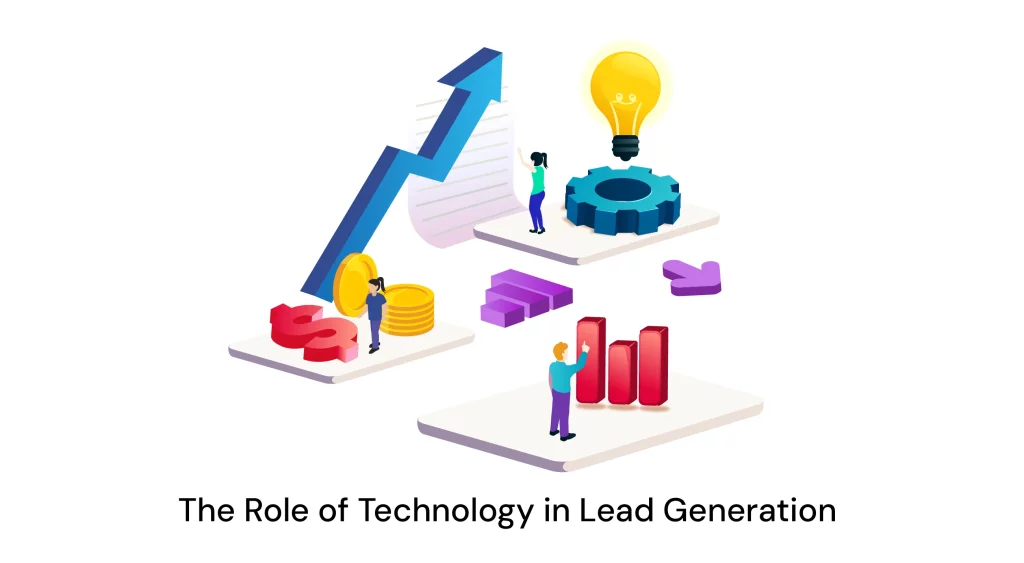
Technology plays a significant role in today’s lead generation market. Before the sales team used to move door-to-door to make a sale. Now, technology has overtaken that route.
1. Artificial Intelligence (AI) and Machine Learning (ML)
AI-powered chatbots like Dialogflow and ML algorithms like TensorFlow help businesses analyze consumer behavior in real time. This allows for hyper-targeting and personalized marketing efforts, tailoring messages to respective businesses’ needs and preferences.
By leveraging AI, businesses improve decision-making and become more agile, customer-focused, and, ultimately, more successful in driving growth.
2. Data Analytics
Data analytics plays a crucial role in streamlining marketing strategies and segmenting leads based on the Ideal Customer Profile (ICP).
With the help of big data and analytics, marketers can now make informed decisions and tailor their approaches to meet the specific needs of their target audience.
Moreover, real-time data analytics takes this to the next level by enabling marketers to track website interactions, monitor social media conversations, and analyze customer behavior as it happens.
By using real-time data analytics, businesses can generate high-quality leads, improve conversion rates, and drive revenue growth.
3. Customer Relationship Management (CRM)
Manage lead data, monitor interactions, and understand lead behavior with Customer Relationship Management (CRM) tools. Clodura.AI offers 8 different CRM tools to enhance email marketing and sales automation. These CRM integrations that Clodura.AI provides include:
- Salesforce
- Freshsales
- Pipedrive
- HubSpot
- Zoho
- Microsoft Dynamic 365
- Gmail
- Outlook
4. Social Media Tools
Social Media Tools are essential for building meaningful connections with potential leads and driving lead generation. By leveraging these tools, businesses can engage with their audience, monitor conversations, and run targeted ads to reach potential leads. Key social media tools include:
- Hootsuite for social media management and scheduling
- Sprout Social for social media monitoring and analytics
- Facebook Ads Manager for targeted advertising
- Twitter Ads for real-time engagement and advertising
- LinkedIn Ads for B2B Lead Generation
- Instagram for visual storytelling and engagement
These tools enable real-time listening and response to customer inquiries, allowing businesses to showcase excellent customer service and build trust.
5. Email Marketing Tools
Email Marketing Tools are a vital component of lead generation, enabling businesses to nurture leads through targeted campaigns and automated workflows.
Email marketing tools offer a suite of email marketing tools, including a free email verifier and an AI writer, to help businesses craft effective marketing strategies.
By incorporating Clodura.AI, businesses can create a robust and automated email marketing strategy. Email marketing tools like a free email verifier, AI writer, and QwikMail for generating leads help in doing so. These tools also help in email sequencing with 200 email limits along with multiple sales closures.
6. Sales Intelligence Platforms
Sales Intelligence Platforms, such as Clodura.AI, are a game-changer for lead generation, providing real-time insights that inform sales decisions and drive results.
This comprehensive B2B sales intelligence platform supports various marketing sections, including automation, integration, prospecting, engagement, and nurturing.
Businesses gain real-time visibility into lead behavior, preferences, and pain points, enabling them to identify high-quality leads, prioritize sales efforts, and enhance lead engagement and conversion rates.
How Does the Lead Generation Process Work?
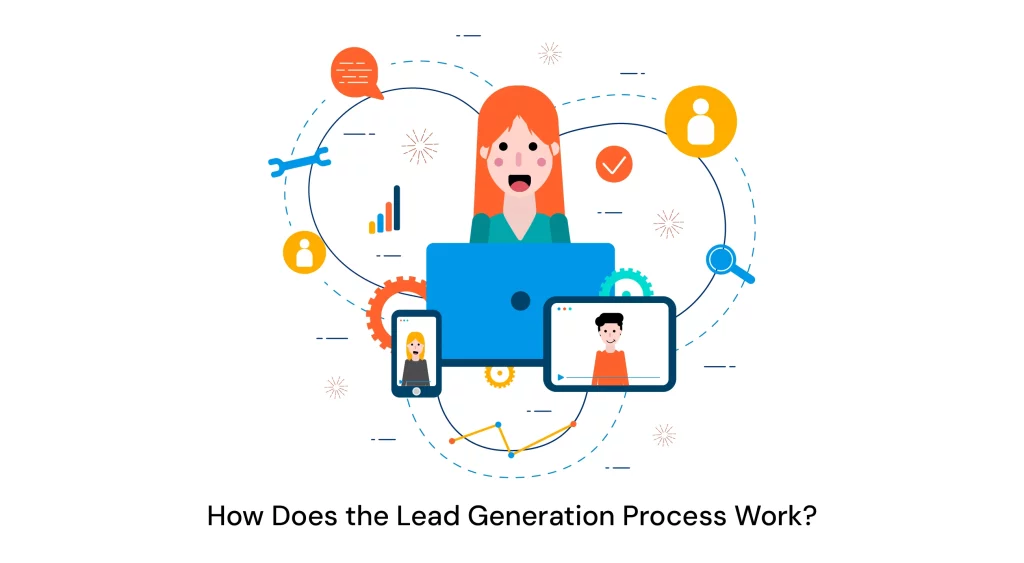
To ensure your lead generation efforts are as effective as possible, here are the top 10 essential steps to follow:
Step 1: Identify Your Target Audience
- Define Your Ideal Customer: Create detailed buyer personas based on demographics, industry categories, job roles, pain points, and buying behavior.
- Conduct Market Research: Use surveys, customer feedback, and market analysis to gather insights into your target audience’s needs and preferences.
Step 2: Create Valuable Content
- Develop High-Quality Content: Create blog posts, whitepapers, eBooks, webinars, infographics, and videos (podcasts and product demos) that address the needs and challenges of your target audience.
- Optimize for SEO: Use relevant keywords, meta descriptions, and contextual link building strategies to create quality backlinks that improve search engine rankings and attract organic traffic. Google SERP API can also help analyze search results and identify opportunities for optimization.
Step 3: Leverage Social Media
- Engage on Social Platforms: Share your content, interact with your audience, and promote your brand on platforms like LinkedIn, Facebook, Twitter, and Instagram.
- Run Paid Social Ads: Use targeted ads on social media to reach specific segments of your audience based on demographics, interests, and job roles.
Step 4: Optimize Your Website and Landing Pages
- Enhance User Experience (UX): Ensure your website is user-friendly, mobile-responsive, and has fast load times. Using web development services can enhance design and functionality, helping to create effective landing pages with clear Calls to Action (CTAs) to convert visitors into leads.
- Create Effective Landing Pages: Design landing pages with clear Calls to Action (CTAs) and minimal distractions for specific offers such as eBooks and webinars.
Step 5: Use Lead Magnets
- Offer Value in Exchange for Information: Provide something valuable, such as a free guide or trial in exchange for visitors’ contact details.
- Implement Gated Content: Use forms to collect information before granting access to valuable content, effectively capturing leads.
Step 6: Implement Email Marketing
- Build and Segment Your Email List: Collect email addresses through lead capture forms and segment the list based on behavior and demographics.
- Automate Email Campaigns: Send targeted, automated emails that nurture leads over time and guide them through the buying process.
Step 7: Utilize Paid Advertising
- Run PPC Campaigns: Use Google Ads or similar platforms to run targeted Pay-Per-Click campaigns that drive traffic to your site.
- Use Retargeting Ads: Implement retargeting ads to re-engage visitors who previously visited your site but didn’t convert.
Step 8: Engage in Networking and Partnerships
- Attend Industry Events: Participate in trade shows, conferences, and networking events to connect with potential leads directly.
- Form Strategic Partnerships: Collaborate with other businesses to cross-promote and reach a broader audience.
Step 9: Use CRM and Lead Management Tools
- Implement a CRM System: Use tools like Salesforce or HubSpot to manage your leads, track their journey, and nurture them effectively.
- Utilize Lead Scoring: Prioritize leads by scoring them based on their conversion likelihood, ensuring your sales team focuses on the most promising leads.
Step 10: Analyze and Optimize
- Track Key Performance Metrics: Monitor conversion rates, cost per lead, and ROI to evaluate the success of your lead generation efforts.
- Conduct A/B Testing: Constantly test and optimize elements such as landing page designs, CTAs, and ad copy to improve results.
Following these steps will help you build a strong lead-generation strategy that attracts, nurtures, and converts potential customers into loyal clients.
5 Types of Lead Generation to Target an Audience
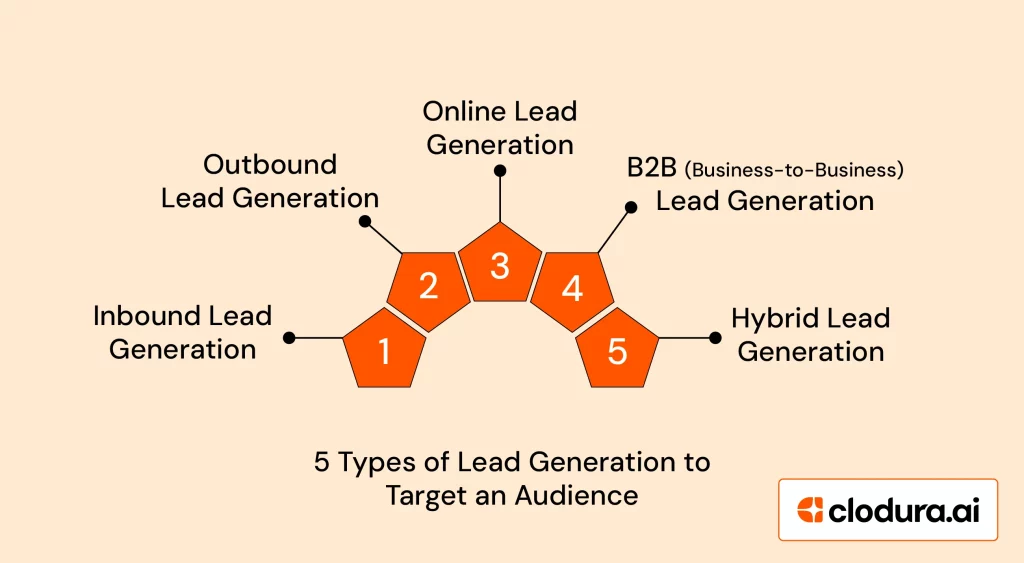
There are multiple ways of generating leads. Some common types of lead generation include:
1. Inbound Lead Generation
This type of lead generation helps attract different leads by utilizing valuable content and experiences like articles, case studies, and whitepapers.
Inbound lead generation draws people in by offering valuable information that handles their issues and queries. Some examples of inbound lead generation include:
- Content Marketing – Developing and sharing relevant and helpful content like whitepapers, case studies, articles, and blogs to attract leads.
- Social Media Marketing – Posts ads, and interactions on social media help businesses engage with leads that draw them in. Platforms like LinkedIn, Instagram, Facebook, and TikTok can help in acquiring these leads effectively.
- Online Events and Webinars – Hosting important sessions and webinars helps leads gather valuable information, resulting in their acquisition.
- SEO (Search Engine Optimization) – SEO (Search Engine Optimization) – SEO helps in gathering organic traffic through website content that ranks higher in the search engine. Utilizing a professional links building service can significantly boost these efforts by improving your site’s authority and search visibility.
- Email Marketing – Lead nurturing through targeted emails and acquiring email addresses through sign-ups.
2. Outbound Lead Generation
Outbound lead generation involves reaching out to prospects and leads to generate interest in buying the company’s service or product.
Instead of providing valuable content, like inbound lead generation, outbound lead generation engages with potential customers who have not yet expressed any interest in the product. Below are a few examples of this:
- Direct Mail – Sending mail in a physical format like letters, brochures, and postcards to attract leads.
- Advertising – Releasing paid ads on social media, search engines, or other platforms to reach the right leads.
- Cold Calling – Calling the prospect directly via phone to pitch products or services. Clodura.AI helps in achieving this as it has 120M+ direct dials along with a calling integration feature that provides a dialer to call the lead directly without moving to any other platform.
- Cold Emailing – Sending emails to potential leads in the hopes of conversion. Clodura.AI has an AI-writer that can personalize emails that fit the ICP and send them to the lead’s designated inbox.
3. B2B (Business-to-Business) Lead Generation
Identifying and drawing a business in to buy another company’s products and services is called B2B lead generation.
Unlike B2C companies that focus on individual marketing, B2B lead generation has profiled businesses and organizations as their target audience. Below mentioned are a few examples of B2B lead generation:
- Account-based Marketing – Focusing on the target companies with personalized marketing efforts.
- LinkedIn Marketing – LinkedIn is the go-to website for B2B marketing where multiple companies market their product/services.
Clodura.AI provides a feature called LinkedIn automation that helps in directly connecting with the user through the Chrome extension. It helps to target soft leads and engage them regularly on LinkedIn.
- Industry events and trade shows – Event participation and trade shows help in engaging with potential business clients.
4. Online Lead Generation
As the name suggests, online lead generation takes things online and leverages different tools and strategies that help in reaching out to potential customers effortlessly.
This type of tactic helps reach a wider audience which offers accurate results to pinpoint areas of improvement. Below mentioned are a few examples of this:
- Lead Magnets – Providing free-to-use resources like eBooks, checklists, and templates in return for contact information.
- Landing Pages – Developing optimized landing pages that serve the purpose of only acquiring leads.
- Chatbots and Live Chats – Collect lead information and engage new visitors on the website through live and automated chat services.
5. Hybrid Lead Generation
Hybrid lead generation is a combination of offline and online lead generation that helps in acquiring leads.
Combining both offline and online channels can help businesses tap different prospects across different touchpoints. This boosts the probability of acquiring high-quality leads. Some of its examples include:
- Online ads with offline events – Online ads promote offline events to collect more leads. For example, flyer templates can be distributed at local stores or cafes to encourage foot traffic to events, while online ads generate digital awareness.
- Webinars with follow-up calls – Hosting online webinars followed by direct dials helps in not only collecting leads but also improving existing relations with them. Both live and pre-recorded webinars aid in generating high-quality leads.
Online lead generation leverages multiple tools and strategies to reach potential leads. Implementing AI lead generation can improve these efforts through automated software which will be later discussed in this article.
10 Effective Strategies to Generate Leads
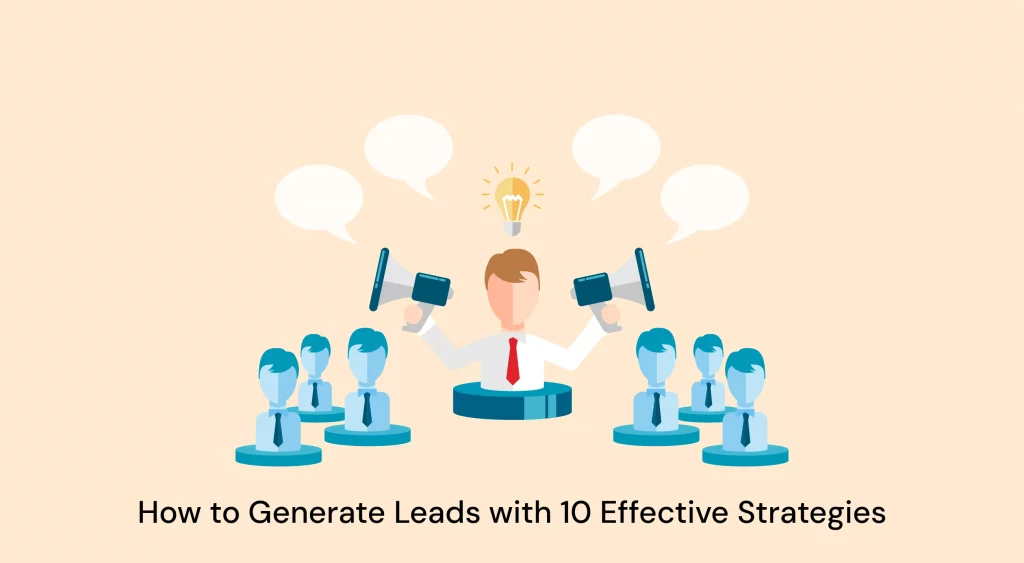
Generating leads is simple yet complex for many. This is why there are multiple strategies to facilitate leads. Let us take a look at 10 of the best strategies:
1. Address the Audience’s Pain Points
Strong content is the cornerstone of effective lead-generation strategies. Creating strong content is simple. Address your target audience’s pain points like iterative sales tasks or a limited contact data pool and show them how your product/service can solve those issues.
For instance, if a business is offering email marketing software, it helps users out a lot if the marketing team creates multiple videos about ‘tips to develop a sales funnel’ or case studies related to the topic for better reliability.
Clients love to see robust evidence that can back audacious claims businesses have about their products.
2. Analyze and Adjust Paid Campaigns
Frequently reviewing and adjusting your bidding in PPC campaigns is another incredible strategy for creating leads. Constantly checking the ad performance and optimizing for better CTRs helps to boost conversion rates of leads.
Businesses also ensure that they re-target and re-purpose ads to visitors who interact with their product/services but never take further action.
3. Utilize Analytics Tools for Valuable Insights
Analytics tools help in analyzing the email campaign’s performance. Tools like Marketo, HubSpot, and Google Analytics are a few that can analyze your lead generation campaigns.
Combining B2B data from different sources like social media, CRM, and email marketing helps in viewing the data holistically.
The above-mentioned tools can sometimes be difficult for small businesses to afford. This is where Clodura.AI steps in with a sales cadence that helps in analyzing the holistic view of the email campaigns.
4. Assign a Lead Scoring System to Your Team
A lead scoring system establishes a point-based system based on certain actions, such as webinar attendance, whitepaper installations, or engagement with top-ranking pages.
The leads that consistently visit your website are assigned a higher score than the ones that occasionally do it. The prospects that are assigned higher scores are the ones that the sales teams of a business will focus on for further conversion.
5. Leverage Marketing Automation for Better Targeting
Nurturing leads can be done by automated email sequences based on their behaviors and engagements. Email automation helps in executing email campaigns with cutting-edge automation capabilities.
Clodura.AI is one such tool that provides email automation through its AI writer. It can easily nurture leads and drive conversions with personalized email sequences crafted to streamline the user’s outreach.
6. Target your Audience’s Social Media Channels
Social media outreach is another one of the strategies that helps in effectively generating leads. Finding the target audience on the right social media platform is one of the keys to customer acquisition success.
If a buyer is active on LinkedIn but the business has profiled their lead generation campaign on their Facebook audience will rarely get them high-quality leads. This is why it is important to understand the right platform on which your audience resides.
7. Provide Free Tools Attracts more Buyers
A free tool seems like a healthy opportunity for the visitor/buyer on your website. Since free tools do not require much time or money to invest in, leads are generated effortlessly.
Generating leads through Clodura.AI is free. It provides a free email verification platform that not only checks the email addresses of a certain contact but also verifies its legitimacy.
8. Craft Engaging Call-To-Actions (CTAs) for Conversion
Call-to-actions (CTAs) that are crafty and witty help at times when lead conversions are least expected.
Regardless of the channel, the business is campaigning on, a clear and concise CTA can help in attracting leads quicker, enhancing the conversion rates of the website. Just add these CTAs in the sign-up forms backed by testimonials.
9. A/B Test Approaches for Best Results
A/B testing helps in focusing on different audiences with different strategies. It is a ‘try and test’ strategy that runs multiple forms of a single variant and determines which version is the most effective.
Businesses must analyze the open rates of their emails based on their email subject lines to understand the most efficient messages, which further optimizes their email campaigns for better conversions.
10. Improve Your Website and Landing Pages
The dropoff rate of visitors is quite high when it comes to landing page content. Make sure to improve site navigation, mobile responsiveness, and loading speed.
Another great way of retaining a landing page visitor is by simplifying the fill-up forms, which do not take too much of the visitor’s time or energy.
5 Common Challenges Faced in Lead Generation
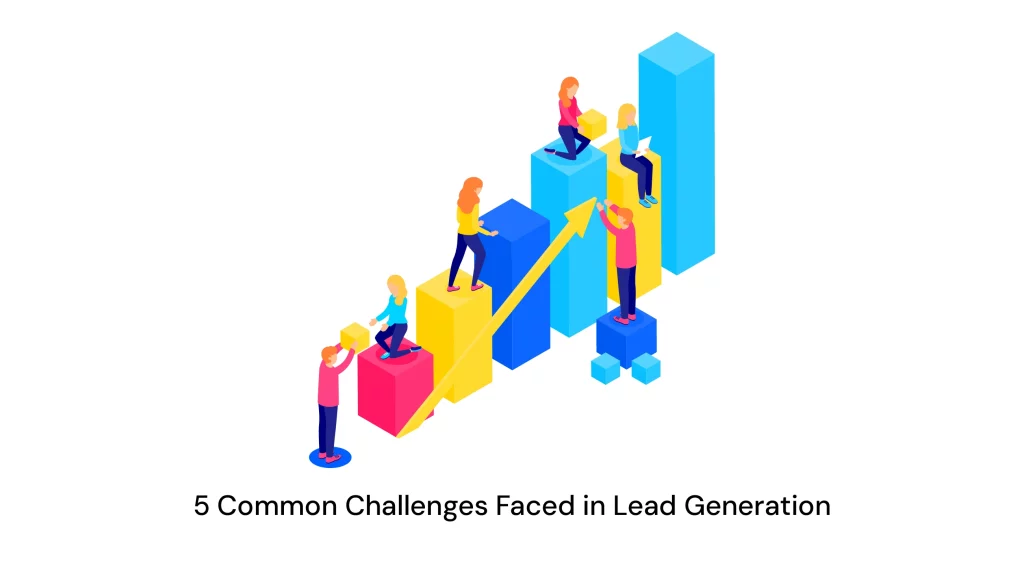
Let us take a look at a few issues and challenges that sales teams face during their lead-generation process:
1. Target the Wrong Audience
Problem: Marketers might constantly target the wrong audience and wonder why their lead-generation strategies fail.
Solution: The key is to target the audience genuinely interested in the product/service your business strives to offer.
To do this right your market research must be precise on your target audience and create buyer personas and ICPs. Such a strategy will resonate with the right audience interested in buying your product/service.
2. Unorganized Website with Errors
Problem: Visitors will likely stop visiting if your house lacks organization and cleanliness. Similarly, an unorganized website will seldom generate leads. Issues could include poor website design, no discounts or offers, complex forms, etc.
Solution: To solve this, businesses must optimize their website’s user experience, facilitate simple forms, and introduce enticing offers that speak to their audience.
3. Poor Lead Nurturing
Problem: Another issue arises when it comes to lead nurturing. Providing leads with relevant, unique, and timely content to guide them through the sales funnel can be exhausting
Solution: Businesses can solve this issue by segmenting the leads and then crafting personalized email messages to send them. This might resonate with the lead as it targets their issue specifically.
4. Integration Error Between Sales and Marketing Teams
Problem: Integration and alignment errors between the sales and marketing teams can often lead to the downfall of lead generation.
Solution: Businesses must ensure seamless and fluid communication and cooperation between these teams to create a proper lead handoff without letting the lead slip through the cracks.
5. Restricted Budget Limit
Problem: The overlying issue for the majority of startups and small businesses is operating on a shoestring budget. How can businesses with limited budgets solve this problem?
Solution: Implement lead generation strategies such as content marketing, SEO, and social media to combat your budget issues. The most successful strategy for helping businesses out is organic content. Such content can reach and interact with potential leads without much finance.
These are a few looming challenges that trouble marketers while generating leads. Numerous lead generation metrics can help them spot the KPIs in their lead generation process.
5 Best Lead Generation Tools to Boost Sales
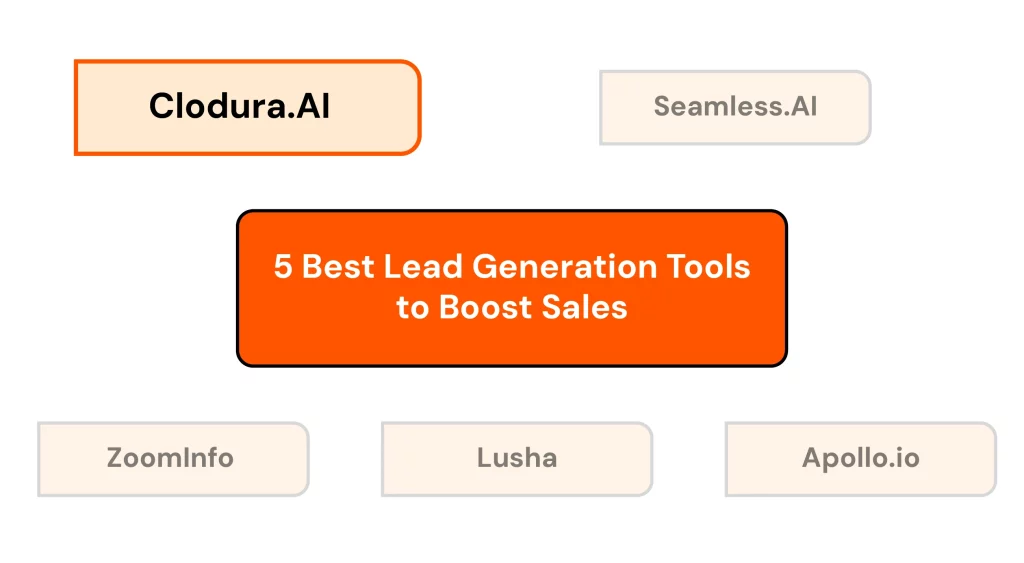
To combat the lead dropoff rate, businesses must implement the right and best lead generation practices. However, doing that manually can be challenging. This is where lead generation tools enter the picture.
The best lead generation software provides features like email automation, sales engagement, B2B data, etc. Let us take a look at a few lead-generation tools to enhance the sales pipeline:
1. Clodura.AI
Clodura.AI is an AI-driven lead-generation software that generates leads and helps users target and automate email sequences for the right audience.
- B2B Database: The tool has a database of 600M+ contacts with 95% accurate data and offers 120M direct dials that help the user access a large pool of contact and company data.
- Organizational Charts: Clodura.AI provides 45M+ organizational charts that help the user access company structures to identify cross-selling opportunities.
- Advanced Filters: The sales prospecting tool has 30+ advanced filters that can help users sort prospects based on location, company revenue, industry, etc., that will fit their ICP.
- Chrome Extension: Furthermore, Clodura.AI’s free email and direct dial finder Chrome extensions allow users to acquire information regarding a contact through LinkedIn.
- AI-writer: Finally, its AI writer can start crafting compelling cold emails and send them to designated verified inboxes.
If you want to enhance your sales pipeline through lead generation, Clodura.AI is right up your alley.
2. ZoomInfo
ZoomInfo is a B2B database that offers valuable insights on companies and contacts through LinkedIn. It provides features like sales intelligence and prospecting that help its audience improve their outreach.
However, their subscription plans are pricey, which is why only large and established businesses can afford them.
You can learn more about ZoomInfo competitors.
3. Apollo.io
Similar to ZoomInfo, Apollo.io is also one of the major tools that marketers use to generate potential leads. It also provides other features like email outreach, prospecting, and more.
Apollo.io is used to target key decision-makers that can impact the decisions of an organization. However, multiple reviews dislike its email deliverability rate, claiming it was inconsistent.
You can learn more about Apollo.io competitors.
4. Seamless.AI
Seamless.AI is another lead generation software that helps in not only acquiring leads but also in building the sales pipeline that enhances the sales cycle. It is a premium tool that helps small and large businesses in sales automation and email sequencing.
However, there are reports of data inaccuracy and a limited database that annoys a lot of Seamless.AI users.
You can learn more about Seamless.AI competitors.
5. Lusha
Last on the list, Lusha is a lead generation tool that connects users with verified B2B data for efficient lead acquisition. This tool is highly used in the marketing community as it is budget-friendly.
It provides features like intent data, enrichment, and API integration. However, sources claim that it is also highly inaccurate in data verification with a buggy user interface.
You can learn more about Lusha competitors.
Get A Sales Intelligence Platform That Does It All
Clodura.AI is an effective B2B lead-generation tool that simplifies the lead-generation process since it is a one-stop solution for your email marketing purposes.
Book a DemoGenerate High-Quality Leads with Clodura.AI
Generating leads might sound complex at first but is quite simple on the contrary. All you need to have is a clear vision of your target audience and certain tools to make the process easier. Clodura.AI is a B2B lead generation tool that is the solution to all your problems.
The platform provides more than 30 advanced filters that can instantly access, profile, and reach 600M contacts in under 3 minutes. Hence, this makes it an efficient B2B lead generation tool.
Furthermore, it also provides sales enrichment that helps out in keeping the data fresh and constantly updated with more than 40 attributes.
Clodura.AI’s sales enrichment supports sales and marketing managers. Additionally, it also comprises more than 15,000 technology products that facilitate hyper-targeted campaigns.
Frequently Asked Questions on Lead Generation Guide
1. How to choose the right lead generation strategy for a B2B business
The right lead-generation strategy will be based on your business goals, target audience, and resources. Figure out the medium where your audience is available, online or offline. Test both inbound and outbound strategies with content marketing, cold emailing, or social media outreach. Clodura.AI helps in solving these issues with the AI writer that can be used for cold emailing and content promotion on social media and other channels.
2. How can small and medium businesses benefit from lead generation?
Since small and medium businesses have a constrained budget, they must gain traffic organically. This results in building their sales pipeline, which leads to increased revenue generation. Generating leads effectively also helps build brand awareness and allows SMBs to take the lead by nurturing relationships with existing customers against their competitors. Since Clodura.AI provides cost-effective solutions starting at $90, SMBs can leverage its features seamlessly.
3. Can Clodura.AI be customized to fit my business-specific lead generation needs?
Yes, Clodura.AI can be customized to your specific business needs. The platform has versatile solutions that help you set filters for your industry, unique sales processes, and target audience. For example, you can set filters for lead scoring and choose data that aligns with your business objectives.
4. Can Clodura.AI scale to meet the growing needs of your business as you acquire more leads?
Yes, Clodura.AI can meet the dynamic, growing needs of your organization to acquire more leads. It is designed to handle large amounts of data, which helps to manage bigger lead pools without jeopardizing the performance. The scalable structure of Clodura.AI can support team growth, evolving prospects generation strategies, and ensuring lead monitoring, and conversion as the business expands.
5. What is the best way to nurture leads?
Businesses nurture leads to improve their relations with existing clients. Craft content that streamlines with the audience’s interests and pain points. Send and follow up on the regular emails that contain valuable and relevant information. Provide the audience with enough incentives so they can purchase your product. Based on leads’ engagement and their likelihood to convert, assign them scores.
6. How can sales and marketing alignment issues impact lead acquisition, and how can they be resolved?
Sales and marketing alignment is crucial for successful lead acquisition. Misalignment can lead to wasted efforts and missed opportunities. To resolve this, ensure both teams share common goals, understand their roles, and utilize a CRM to centralize and track leads. Regular meetings help keep strategies aligned and address any issues promptly.
7. What are the benefits of using AI in lead generation?
AI can be very helpful in lead generation. It helps with tasks like lead scoring, email personalization, and customer segmentation. AI Marketing Analytics Tools can also review and analyze mountains of data to identify patterns and potential opportunities, making your lead-generation efforts more efficient and effective.



Published on: September 27, 2024 |
Share: